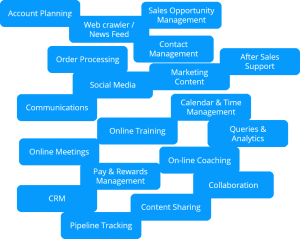Key Account Management- How Has It Evolved? Part 5
- By Beth Rogers
- Posted 04/2019
- 4 Min Read
- BlogsEventsThought leadership
The relevance of sales enablement to KAM
The definition of sales enablement relevant to this discussion is ‘’The sales infrastructure that facilitates and supports the effectiveness and efficiency of salespeople and sales activities.’’
Sales enablement encompasses the company’s investment in process design, technology, systems, training, tools and sales support teams. Much focus is put on the technology in many organisations, but technology cannot enable without being positioned among other resources and capabilities, all of which must be integrated and strategically directed towards achieving company objectives.
Typically, a sales enablement system in a company has senior-level sponsorship and is regarded as strategically important. It includes technology, content and coaching and enables communication and customer engagement. This section will focus primarily on the technology, which is a vital element in the future business model for key account management programmes. Nevertheless, it is understood that training and coaching are essential to the key account team’s ability to leverage the potential of the technology.
Sales Enablement – Elements
The elements of a sales enablement system or a sales technology stack can be clustered into five categories;
- Improving the sales process
- Leveraging customer information
- Making marketing more personalised
- Improving communications and connectivity within the organisation and with customers
- Serving the sales employee (e.g. pay and training)
(Detailed elements are shown in the chart below).
It is important that the system is designed to align with the customer’s buying preferences and provide an easy and high-quality experience (13). From the salesperson’s point of view, the system should prompt about who to engage with and when and what content and messages to use. The system should flag up what is working and what is not (and perhaps why).
Figure 1: Elements of Sales Enablement

As well as providing functionality, sales enablement also needs to be easy-to-use. The application of technology to the customer interface does not have a happy history, and some account managers would still complain about their customer relationship management system being clunky. Whatever technology is used as the foundation, when a key account manager comes to use it, it must be useful and usable (14). Modern systems are expected to be intuitive, visually engaging and very fast. Queries are expected to generate meaningful messages so that the user can find what they want.
What is the System Supposed to Achieve?
Any technology application should be judged by its contribution to business objectives and benefits (15). Of eleven detailed objectives for sales enablement systems noted in a recent research report (13), six concerned increasing revenue and five were focused on the efficiency of the salesperson. Notably, employers expect sales enablement systems to reduce the administrative burden on the salesperson. The report found that respondents with mature sales enablement systems did report better sales performance.
**************************************************************************
Possible objectives for sales enablement:
Revenue-oriented:
- Increase share of purse with current customers
- Improve win rates (acquire new customers)
- Reduce customer churn rates
- Targeting the right customers at the right time
- align with the customer’s buying journey and reduce sales cycle time
Efficiency-oriented:
- Reduce cost of selling
- Making the customer’s buying journey easier
- Increase selling time per salesperson
- Reduce sales staff turnover
- Improving visibility of the sales pipeline
**************************************************************************
Tracking cause and effect
The role that the sales enablement system plays in key account management is vital and becoming more so. First, it is worth discussing the chain of events that lead to business benefits being derived from technology (15).
Technology can enable changes in the way a company does business; typically it is supposed to make something happen faster or more accurately. In most cases this business change should deliver a tangible business outcome, typically reduced cost. Reduced cost is sometimes seen as an end in its own right, but of course the aim of reducing cost is to achieve better profitability which can provide bigger dividends for shareholders or low-risk investment funding for the business.
In the case of technology applied at the customer interface, the chain between the deployment of the technology and realised benefits is longer (16). The technology has to deliver something in the way a supplier does business (typically the behaviour of sales staff) which has to first of all motivate the customer to do more business with them, and then actually change the customer’s behaviour to place the orders.
Figure 2: Time to Revenue

The KAM Angle
All the factors explored above are relevant to key account management, but the picture is more complex because the end game is that both the supplier and the customer should be able to capture value from the relationship over a period of time, which may be difficult to measure.
Value can be growth and/or profitability; it might also be improved brand valuation or improved capabilities. A critical reason for forging a long-term business relationship will be the desire to reduce risk. For both supplier and key account to believe that the benefits have been realised, monitoring over time and against a forecast business case is necessary, and it is more believable when a shared system is doing the tracking.
Stepping back, the customer’s motivation to change to a new supplier or do more business with an existing supplier will require trust in that supplier’s efficiency and deep understanding of their needs. As noted earlier, buying professionals continue to complain that salespeople do not do enough homework on their needs. This just cannot be tolerated in key accounts; there must be a way of analysing the customer’s needs in depth and designing innovative solutions.
Typically, the key account teams need an enablement system that includes business environment trends, sector analysis, account –specific customer analysis, competitor research, product information and competency information. The more work that can be done by the technology integrating data sources and providing analysis and insight to the key account team, the more productive the key account manager can be.
The usefulness of an enablement system is multi-faceted. For a key account team, the following two quests are top of the requirements list:
The generation of insight
An API (Application Programming Interface) is a way for one application to ask another to run a routine or provide some data. It makes it possible for software from different suppliers to be integrated, and for different systems in different organisations to be integrated. New platform technologies such as blockchain can improve traceability and data-sharing.
Key account teams need to access information from across their company, customer, products within the key account (via sensors?), partners, maybe technical institutes, newsfeeds and social media sources. This data must be crunched by the sales enablement system to provide meaningful analysis and insight that the team can use to make interesting proposals to key accounts in a timely fashion. An ideal is to know the key account’s needs before they do. Buyers do sometimes observe that capability in a supplier; that is when they acquire the right to be a “trusted advisor”.
Ensuring the Ease of Doing Business
The automation and integration of marketing and sales processes often results in over-standardisation, but modern enablement systems should be able to treat a key account as a market of one. Messages, transactions and information exchange should help that account to meet their goals (as mapped in the account plan) milestone by milestone, with appropriate monitoring and measurement, and as smoothly as possible. The process becomes a service which adds value to the key account as they use the supplier’s products (value-in-use). Post-sale process integration is becoming more important than anything that happens pre-sale.
We can be sure that sales enablement systems will grow in functionality. Sometimes, it is organisations’ reluctance to adopt the most flexible and up-to-date system which leaves key account managers preparing their own spreadsheets for value mapping and “papering over the cracks” of clunky technology. When thought leaders in key account management are asked about the future of KAM, technology generates by far the most discussion.
Notes:
- CSO Insights (2018). Sales Enablement Grows Up: 4th Annual Sales Enablement Report https://www.csoinsights.com/
- Davis, F. D. (1989) ‘Perceived usefulness, perceived ease of use and user acceptance’, MIS Quarterly, Vol. 13, No. 3, pp. 319–340.
- Ward, J. and Elvin, R. (1999) ‘A new framework for managing IT-enabled business changes’, Information Systems Journal, Vol. 9, No. 3, pp. 197–221.
- Rogers, B., Stone, M., & Foss, B. (2008). Integrating the value of salespeople and systems: Adapting the benefits dependency network. Journal of Database Marketing & Customer Strategy Management, 15(4), 221-232.







